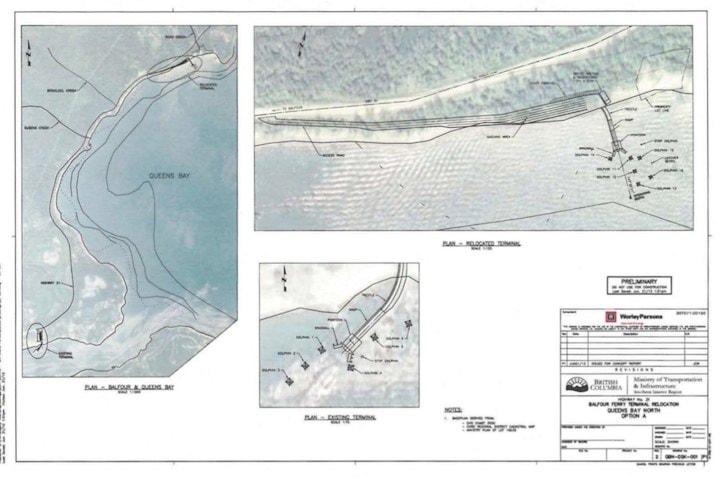A 2012 consultant’s report suggested a site on the north side of Queens Bay as the best bet for a new Kootenay Lake ferry terminal.
The study, completed by WorleyParsons Canada of Burnaby for the Ministry of Transportation, was obtained by the Star through a Freedom of Information request.
Recently, the ministry confirmed it continues to explore the idea of moving the western terminal before it commits to major capital investments to the Balfour dock. However, it's expected to take years to become reality if it ever does.
“There [would be] a potential increase in service levels, a reduction in operating costs, and improvement in overall risk profile for the Kootenay Lake ferry service if the terminal on the west side is relocated from Balfour to Queens Bay,” the relocation study’s summary reads.
The study looked at four potential locations at Queens Bay, two on the north side and two on the south. While all were considered viable, a site on Crown land half a kilometer south of McEwan Point and adjacent to Highway 31A was identified as the most promising spot.
A new terminal would have a similar layout to the existing one at Balfour. It would have a new access trestle and abutments. Other existing marine infrastructure would be barged and towed to the new site, forcing the ferry service to shut down for what the report estimates as 60 hours.
At a minimum, a new terminal would have enough space for 160 cars and a building with washrooms, a waiting area, and storage and maintenance space. Tourist facilities including retail, concession, and green space were deemed desirable but not essential, and their inclusion would depend on available land, the report says.
Building a new access road was considered the “greatest technical challenge and risk to the project.” Although the highway is near the shore, it is “significantly” above lake level. The intersection between the new road and highway would require a sharp turn.
“The provision of sufficient space for trucks to safely complete the turn would require a large amount of grading and/or retaining walls,” the report says. It might also mean cutting into the bank and partially filling in the shoreline.
Cost estimates unclear
Why move the terminal at all?
The study says it could reduce the crossing time by 20 minutes, and moreover, the Balfour landing is “not ideal” due to a variety of reasons:
• The present, diagonal route is longer than a straight crossing between Kootenay Bay and Queens Bay. The ferries make U-turns when approaching and departing Balfour, increasing the travel time and the risk of accidents.
• Due to the narrow channel and congestion of the West Arm, the ferries have to slow down considerably before entering.
• The currents are strong, so if a ferry loses power on approach, a collision or grounding is more likely. During low water, propeller damage or grounding is also possible.
• The ferries’ wake affects nearby private pleasure boats, which “generates negative feedback.”
* The ferry dock area is popular with anglers and the resulting congestion is a safety risk.
The study didn’t use geotechnical or weather data and noted that while exposure to wind and wave hasn’t been determined, it could cause significant operational, maintenance, and safety issues.
Nor did the study look at the social or economic impacts of moving the ferry terminal. Although cost estimates were included, they were blanked out in the copy provided to the Star.
The alternative sites were considered less desirable for reasons that included low-lying elevations, unfavorable access, and potential impact on wetlands and private properties. The southern sites would also only reduce the crossing time by ten minutes.
Sites in central Queens Bay were considered too expensive.
The study noted that during the 1990s, the idea of moving either or both the Balfour and Kootenay Bay terminals was “extensively studied” before it was decided to upgrade existing facilities to accommodate the new MV Osprey 2000. Balfour has been home to the ferry terminal since 1947.
